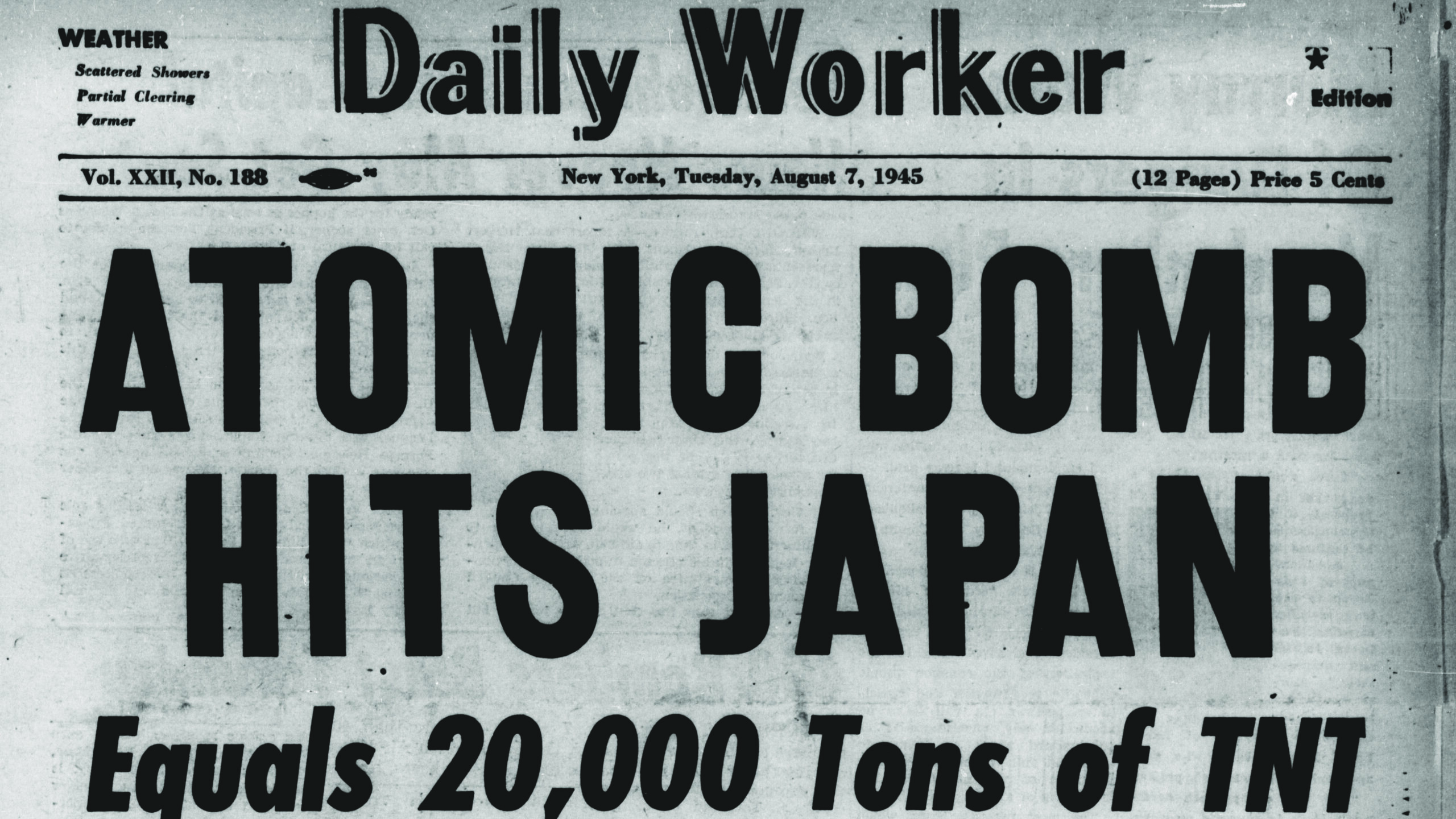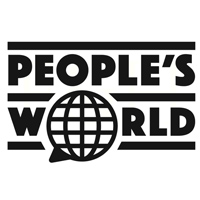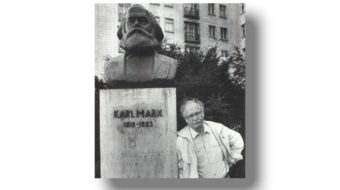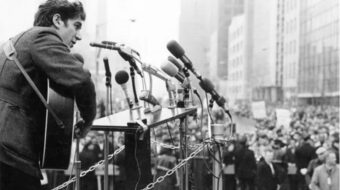
This article is part of the People’s World 100th Anniversary Series.
On Aug. 6, 1945, the United States dropped an atomic bomb on Hiroshima, Japan. Three days later, Aug. 9, it destroyed Nagasaki with a second bomb.
Like the rest of the world, the journalists at Daily Worker, People’s World’s predecessor, were initially in awe of the power of this new weapon. Information was scarce in the early days of the bombings. News of the utter destruction of the two Japanese cities was widely disseminated, but there was little or conflicting information about the radioactivity caused by the bombs and their effect on those who managed to survive the initial blasts.
As the days went by, the true nature of potential threat the bomb posed to humanity became more apparent, and the Daily Worker endeavoured to present those facts, even as it pushed for a rapid end to World War II.
By Aug. 13, just a week after Hiroshima, Communist Party USA leader William Z. Foster was issuing an urgent wake-up call about the dawn of a new age of atomic danger. He warned that this new power could not be left under the control of reactionary U.S. imperialism alone. Foster called for the internationalization of atomic power under the control of the United Nations Security Council, saying capitalism could not be trusted to pursue its peaceful use.
His warning became reality, as the Cold War era of nuclear confrontation was soon underway.
Below, we present a selection of Daily Worker article excerpts from those first days of the atomic age.
ATOMIC BOMB HITS JAPAN
Daily Worker | Aug. 7, 1945
WASHINGTON, Aug. 6—The most terrifying engine of destruction ever devised by man—an atomic bomb carrying the explosive force of more than 20,000 tons of TNT—was turned loose against Japan Sunday as American airmen opened a “surrender or else” assault against the enemy homeland.
President Truman, revealing the biggest and best kept military secret of the war—the long dreamed-of release of atomic energy—said today that the awesome weapon was America’s answer to Japanese rejection of the Potsdam surrender ultimatum.
In what amounted to a new ultimatum, he warned: “If they do not now accept our terms, they may expect a rain of ruin from the air, the likes of which has never been seen or heard.”
So mighty is this superbomb, he said in a special statement, that it packs 2,000 times more wallop than the 22,000-pound British “Grand Slam” blockbuster, heretofore the most destructive weapon known to mankind.
The first of the bombs went smashing down on Hiroshima, important Japanese army base on the home island of Honshu. The devastation wrought is not yet known, but military men said the bomb’s potentialities stagger the imagination.
Details of the weapon must remain a military secret, but the War Department disclosed that one of its chief components is radioacitve uranium, a rare element in the chromium group found in a combination of pitchblend and certain other rare minerals.

It also is the first known time that atomic energy has been harnessed for such purposes outside the laboratories. Mr. Truman disclosed that the Germans had been working feverishly, but in vain, to perfect such a bomb when they surrendered.
Secretary of War Henry L. Stimson said, “It is abundantly clear that the possession of this weapon by the United States, even in its present form, should prove a tremendous aid in shortening the war against Japan.”
He also revealed that a more powerful type, increasing by “several fold” its destructive fury, will be “forthcoming shortly.”
—
Fliers Tell of Atom Bomb Raid – Boiling Smoke Engulfs City
Daily Worker | Aug. 8, 1945
GUAM, Aug. 6—The first atomic bomb to fall on Japan caused Hiroshima to disapear in a cloud of boiling smoke and flame, according to the men of the Superfortress crew who unleashed nature’s harnessed fury on the helpless Japanese empire.
The men of the crew exclaimed as one: “My God!”
What had been Hiroshima going about its business at 9:15 o’clock of a sunny morning went up in a mountain of dust-filled smoke, black at the base, towering into a plume of white at 40,000 feet.
Here at Guam this morning, pilots reported they said Hiroshima was blotted out first by a flash as brilliant as the sun.
“It was hard to believe what we saw,” one said. “Below us, rising rapidly, was a tremendous black cloud. Nothing was visible where only minutes before the outline of the city with its streets and buildings and waterfront piers were clearly apparent.
“It happened so fast we couldn’t see anything and could only feel the heat from the flash and the concussion from the blast.”
—
Hiroshima Erased, Says Foe
Daily Worker | Aug. 9, 1945
GUAM—Hiroshima, Japan’s seventh largest city, was virtually obliterated by fire and heat from the atomic bomb, enemy broadcasts reported today. Sixty percent of the city’s built-up area was smashed, burned, and disintegrated into rubble, raising the possibility that as many as 200,000 of Hiroshima’s 340,000 residents perished or were injured.
Tokyo said Hiroshima was utterly ruined, leaving seared and blistered corpses “too numerous to count” in the wreckage of office buildings, industries, and homes leveled by exploding atoms.
The enemy reported that as late as Thursday morning—four days after the attack—they still were unable to ascertain the full extent of damage.
Still avoiding the use of the word “atomic,” Tokyo said the “new-type” bomb had “completely destroyed” Hiroshima.

“The impact of the bomb was so terrific that practically all living things, human and animals, were literally seared to death by the tremendous heat and pressure engineered by the blast,” Tokyo said. “All of the dead and injured were burned beyond recognition.
“The effect of the bomb was widespread. Those outdoors were burned to death, while those indoors were killed by the indescribable pressure and heat. Medical relief agencies that were rushed from the neighboring districts were unable to distinguish, much less identify, the dead from the injured.”
“Authorized quarters” in Tokyo charged that the United States had violated the Hague Convention. Japan has never subscribed to the Hague Convention.
—
Atombomb Blots Out Nagasaki
Daily Worker | Aug. 10, 1945
GUAM—Preliminary reports indicated that the second atomic bomb to be dropped on Japan all but obliterated Nagasaki, a major naval base and Japan’s 11th largest city, during the noon rush hour today.
Reports…indicated that Nagasaki, a city of 252,630 persons, virtually had been blown off the map of Japan by an explosion equal to that which leveled 4.1 square miles of Hiroshima.
—
Tokyo Relates Hiroshima Raid
Daily Worker | Aug. 11, 1945
LONDON—A terrible flash of flame which lighted the sky… a city collapsing on its people… bodies and parts of bodies, burned or gashed or both, sticking out of the ruins… That was the description a Japanese soldier gave today of the atomic bombing of Hiroshima.
Broadcast by Radio Tokyo, it was the first eyewitness story of the event which changed world history. A Japanese army corporal, Tokyo said, gave the description:
“I was in a hotel in Hiroshima. About 8:30 a.m., I heard the faint roar of a B-29 cruising overhead. Putting my head out of the window, I looked up.
“As I did, a lightning flash covered the whole sky, blinding me. Unconsciously, I dived for cover. The whole place came down on top of me. I heard a long roar.
“Several minutes later, I was outside, dazed. All round me were dead and wounded with gashes three inches wide on their skins. Some were burnt. Their skins were an awful sight. Then there were small children. Citizens in the street, who were quite happy before, were pitiful to see. Their legs and bodies were scattered about, and debris covered their lifeless bodies.
“It was the most awful scene I have ever witnessed.”
—
The Politics of the Atom Bomb
By William Z. Foster
Daily Worker | Aug. 13, 1945
When the United States launched the atomic bomb upon the Japanese city of Hiroshima, it at the same time precipitated upon the world a major political problem. This has to do with the control of the new, almost fantastic instrument of power.
Atomic power, as scientists and engineers confidently inform us, is capable not only of unparalleled destruction in war, but also of far-reaching consequences in industry. Manifestly, therefore, the control of such a terrific power cannot be left in the hand of reactionaries, who would surely do the peoples of the world immeasurable harm with it.
If such a disaster is to be avoided and the new atomic power which is a product of international science is to be directed to constructive uses, the general military control of it will have to be vested in the Security Council of the United Nations. Also, the plants manufacturing it in the various countries will have to be nationalized.

Moreover, so vital is the whole matter that, more than ever, the masses must see to it without fail that their governments, holding such an incredibly powerful instrument in their hands, are safely controlled by democratic forces who will not abuse its use.
The need for democratic control of atomic power is especially urgent right here and now in the sphere of its military use. To realize the utter folly of allowing reactionaries to control this stupendous weapon, all we have to do is to consider the terrible use Hitler would have made of it had German scientists succeeded in developing it in time. It might well have enabled him to conquer the world, after an immeasurable butchery of humanity.
We must further realize that the reactionaries in our own country, who have in their mind’s eye the imperialist domination of the world, also would not hesitate to use this devastating weapon recklessly in order to accomplish their own reactionary purposes.
This could ruin civilization and, as the scientists warn us, it could also lead to the destruction of the very world we inhabit…. Those who believe that the devastating quality of the atombomb would prevent reactionaries from using it in a new war underestimate the ruthlessness of these people….
Capitalism cannot be trusted to handle the atomic power militarily, nor can it apply it industrially. Only socialism can do these things.
—
500,000 Casualties from Atomic Bombs, Tokyo Says
Daily Worker | Aug. 23, 1945
SAN FRANCISCO—Japanese broadcasts today said atomic bomb raids on the cities of Hiroshima and Nagasaki had cost nearly half-a-million “casualties and sufferers” and levelled buildings within a radius up to ten miles.
Radio Tokyo, in broadcasts recorded by United Press, said effects of the bombs were “monstrous.”
The second atomic bomb dropped Aug. 8 on Nagasaki took a toll of “more than 10,000 persons killed, more than 20,000 wounded, and more than 90,000 rendered homeless in the city,” Tokyo said.
“Even those who received minor burns,” one broadcast asserted, “looked quite healthy at first, only to weaken after a few days for some unknown reason and frequently die.
“Since the explosion of the atomic bomb, an area 30 kilometers in diameter and practically all houses in this area were either blown up, knocked down, or reduced by fire; it is difficult to count all the dead bodies, many of which burned under collapsed buildings.”









